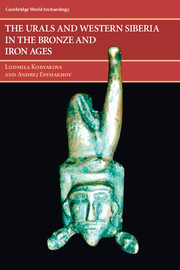Book contents
- Frontmatter
- Contents
- List of Plates, Figures, and Tables
- Foreword, by Philip L. Kohl
- Preface
- Introduction
- PART ONE THE BRONZE AGE: THE RISE OF ECONOMIC AND CULTURAL COMPLEXITY
- PART TWO THE IRON AGE – FORMING EURASIAN INTERACTIONS
- 5 The Transition to the Iron Age and New Tendencies in Economic Development
- 6 The Southern Urals within the Nomadic World: at the Cultural Crossroads
- 7 The World of Cultures of Cis-Urals Forest Zone of Eastern Europe: the Maintenance of Cultural Identities
- 8 The Forest-Steppe Cultures of the Urals and Western Siberia: on the Northern Periphery of the Nomadic World
- 9 Social Trends in North-Central Eurasia During the Second and First Millennia bc
- Notes
- References
- Index
9 - Social Trends in North-Central Eurasia During the Second and First Millennia bc
from PART TWO - THE IRON AGE – FORMING EURASIAN INTERACTIONS
Published online by Cambridge University Press: 03 February 2010
- Frontmatter
- Contents
- List of Plates, Figures, and Tables
- Foreword, by Philip L. Kohl
- Preface
- Introduction
- PART ONE THE BRONZE AGE: THE RISE OF ECONOMIC AND CULTURAL COMPLEXITY
- PART TWO THE IRON AGE – FORMING EURASIAN INTERACTIONS
- 5 The Transition to the Iron Age and New Tendencies in Economic Development
- 6 The Southern Urals within the Nomadic World: at the Cultural Crossroads
- 7 The World of Cultures of Cis-Urals Forest Zone of Eastern Europe: the Maintenance of Cultural Identities
- 8 The Forest-Steppe Cultures of the Urals and Western Siberia: on the Northern Periphery of the Nomadic World
- 9 Social Trends in North-Central Eurasia During the Second and First Millennia bc
- Notes
- References
- Index
Summary
This concluding chapter will summarize the material presented in the preceding chapters and highlight the basic events that occurred in the area under study during the second and first millennia bc.
It would be presumptuous to hope that we could present the course of social development with all its details. We will only try to indicate some features of this process. As mentioned earlier, thirty years ago, the social level of cultures situated on the “barbarian periphery” of the classical civilizations in north-central Eurasia was defined as primitive, and as having evolved gradually in a linear progression from collective to feudal relations. Today, we would suggest that social development in temperate Eurasia occurred cyclically. This territory “knew” both great highs and great lows, glory and declines, technological inventions and adoptions, social consolidations and disintegrations. Perhaps the most important consequence of its development was that this area organically evolved into large networks of Eurasian interactions.
Looking at Eurasian archaeology of the Bronze Age through the “eyes” of the Iron Age, one can see the difference between these two epochs. The latter is more understandable for our modern rational vision. Such notions as value, wealth, prestige, and status are quite close to our estimations. One cannot say the same about the Bronze Age.
The notable rise of complexity characterizes the current situation in Bronze Age archaeology. On the one hand, we see an incredible rise of data deriving from recent discoveries.
- Type
- Chapter
- Information
- The Urals and Western Siberia in the Bronze and Iron Ages , pp. 316 - 338Publisher: Cambridge University PressPrint publication year: 2007



